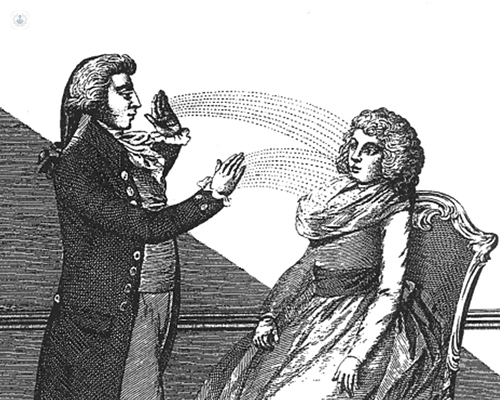Hypnosis through history
Written by:For many people, hypnosis is a man in a hat and cape with a pocket watch; a magic trick performed by entertainers on TV or on holiday. However, it can also be a powerful tool in the world of pain management. Hypnotism in one form or another has been used throughout history to alleviate pain and suffering of patients with mental, physical, and emotional issues, including those undergoing surgery in the days before anaesthesia. Renowned psychologist and practitioner of clinical hypnosis Dr Sue Peacock gives us a brief history of hypnotism and some of the key figures in its development.

Ancient Egypt
There is evidence of hypnosis in ancient cultures, the earliest piece of which was found in a 3,500-year-old Egyptian tomb. It documents how there were “sleep temples” or “dream temples”, where the sick would come to be cured by a priest-physician. The patients would stare at metal discs and fall into a trance, while the priest-physician repeated positive suggestions, which is remarkably similar to techniques used in modern clinical psychology.
Shamanism
Thought to be the oldest and most widespread method of healing in the world, shamanism is largely focussed on a belief in spirits, a spirit world, and magic powers. Shamans and similar folk healers and medicine men appear in indigenous cultures around the world and archaeological evidence suggests that shamanic healing practices have involved elements of ritualised hypnosis for thousands of years, which may explain how they are said to be able to cure people.
Enlightenment
The 18th century saw an intellectual and philosophical movement dubbed “the Enlightenment” or the “Age of Reason”, which emphasised logical thinking and the scientific method. Through the 1700s and 1800s, doctors came to learn about the trance state and, although there were several theories as to how it worked, various doctors began to use hypnotism in their practice and study it scientifically.
Some of the key figures in the development of hypnosis in medicine up to the 20th century are as follows:
Franz Anton Mesmer
The word “mesmerise” originates from this enigmatic and controversial German physician. Wearing a cloak and with a flair for the dramatic, Mesmer was part of the medical community in Vienna and later Paris. His theory was that a natural energy existed in all living things, which he dubbed “animal magnetism”, and if this was blocked by illness, manipulation by a practitioner such as himself could provide a cure. This took the form of hypnotising the patient into a trance state. His theory had a relatively large following between about 1780-1850.
James Braid
Often regarded as the first hypnotherapist and the father of modern hypnotism, James Braid was a Scottish surgeon and “gentleman scientist” in the early 1800s. At first sceptical of mesmerism, he later became interested in the phenomenon, intrigued by the symptoms of those in a trance state. He conducted experiments and studies of hypnosis, identifying key features, such as greater sensory awareness, the ability to recall long-forgotten memories, and the fact that autonomic bodily processes such as heart rate may be controlled to a remarkable degree while in a trance. He doubted the animal magnetism theory, asserting his belief that the trance state was created by the subject rather than the hypnotist, who merely guided the process, and went some way to proving this by experimenting with self-hypnotism.
Braid coined the term “neurohypnology”, later shortened to “neurypnology”. This was also the title of his book detailing 25 cases where he had used hypnotism on patients with a variety of conditions, some unsuccessfully, and others with great success. An example of this was the case of a middle-aged man who had suffered a spinal injury four years previously and had had limited mobility ever since. Braid was able to relieve the man’s pain in his back and arms and return him to work after two months of treatment.
Braid’s scientific approach and theory that trance states are induced and controlled by the mind were instrumental in the history of hypnotism and helped persuade the medical community that it was an area worth studying.
Émile Coué
A French psychologist and pharmacist who noticed treatments seemed to work better after praising their efficacy, in what would become known as the placebo effect. From this idea, he developed a popular method of psychotherapy and self-help known as autosuggestion, which emphasised willpower as key to the healing process. He is known for his mantra "Every day, in every way, I'm getting better and better".
Dave Elman
Born David Kopelman in the US in 1900, Dave Elman would go on to become a multi-talented entertainer and an unlikely key figure in hypnotism. He learned hypnotism techniques as a child to help alleviate his ailing father’s pain, realising their potential for medical application. He became a vaudeville performer in New York, billed as “The World's Youngest and Fastest Hypnotist". Although primarily known as a musician, songwriter, and radio host in his lifetime, medical professionals became very interested in the idea of applying his hypnosis techniques in a therapeutic way, and Elman ended up providing training to doctors and dentists and published various audio-recordings and books on the subject. His technique was known for its rapid induction based on eye closure, much like that of James Braid.
Ernest Hilgard
An American psychologist and professor at Stanford University, where he established a Hypnosis lap. He is famous for studying the effect of hypnosis on pain and for conceiving the theory of the “hidden observer” – a subconscious part of ourselves that can respond without our conscious minds being aware. In practice, this meant that a patient in a trance who had been hypnotised into not hearing anything would respond to questions or instructions by moving a finger, for example, but not recall having heard anything consciously.
Modern day and future hypnosis
In 2016, an fMRI scan performed by Jiang, White, Greicius et al on patients undergoing a guided hypnosis session showed altered activity and connectivity in the parts of the brain involved in focussing attention, controlling the body’s functions, and awareness of both the individual’s surroundings and their own body.
Research into hypnosis in recent decades seems to indicate its usefulness in the treatment of various conditions, particularly in terms of managing pain and anxiety. Some have called for future research into hypnotic suggestibility and the role of the central nervous system in combating disease and how hypnosis could have an impact. It looks like hypnosis has a bright future in pain management.


